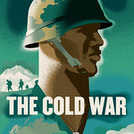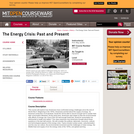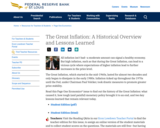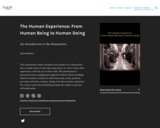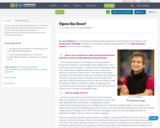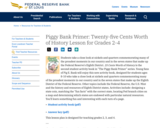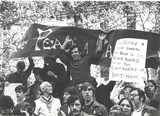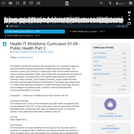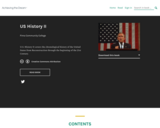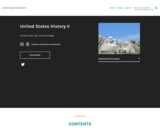From Pre Contact to Post Factual America
Short Description:
A US history ancillary/textbook that examines some traditional some non-traditional aspects of American social, cultural, gender, racial, political, and military history. Most chapters include content provided by community college students.
Long Description:
Historians talk about change over time, but change is not linear. Rather nebulous and with unforeseen consequences. The historian Dr. Nancy Hewitt talks about a complexity of change over time. While change can positively affect one group sometimes that same change negatively affects another group, she argues. Change is both progressive and regressive. Change is embraced and at the same time rejected. The events of January 6th, 2021 demonstrate that.
For example, The territory of Washington granted women the right to vote in 1883, then took away that right in 1887. Women regained the right to vote in 1888 by another act of the territorial legislature, but that bill was overturned by the Territorial Supreme Court the same year. Women in Washington then re-regained the right to vote with the adoption of the new state Constitution in 1910. The Prohibition Amendment was supposed to result in a cleaner, more sober society. What it brought, among other things, was the rise of organized crime. The Eighteenth Amendment was the only change to the Constitution that restricted rights. The idea that change necessarily advances society is inaccurate. In fact, continuity and change can happen simultaneously.
The world is too complex for a linear narrative. The trajectory of society on an evolutionary tract that is positive is not a normal phenomenon. Change does not always mean better. Likewise, continuity has both its detractors and proponents such as the vote in the US Senate for removing the 17th, 37th, 42nd and 45th (twice) president from office after the House of Representatives had found those men guilty of various high crimes and misdemeanors.
Impeachment is not normal. Republicans impeached Andrew Johnson (D) for a myriad of things to include “heaping ridicule upon Congress.” Richard Nixon (R) resigned when it became apparent that he did not have the number of votes in Congress to keep him in the Oval Office. Republicans impeached Bill Clinton (D) for lying about committing adultery. And now the Democrats, who control the House, impeached Donald Trump, twice, including “inciting violence against the government of the United States.” Impeachments are not normal times.
Not unlike Andrew Jackson, Donald Trump attracted exceptionally divergent positions. All presidents have their detractors. Some more than others. Rush Limbaugh seemingly made his career going against the Clinton administration (and women and POC). But the model of this book is not about presidential personalities but rather, for example, are the domestic and foreign policies of presidents more of a continuity of policy, or, are some more in line with Gilded Age policies as some historians have pondered? A change from the path the US has been on since the Progressive era? And, how did those changes and continuities affect various groups of Americans?
The idea of “All men are created equal” didn’t mean “all men” in 1776 but by 1877 “all men” certainly included most American men, at least on paper. Women were granted the right to vote, then Native Americans, then the 1964 Civil rights Act, then the Americans with Disabilities Act. Our liberties seemingly expand over time. But then the Supreme has been chipping away at the 1965 Voting Rights Act since 2013. Then the Dobbs decision (2022) took away a women’s right to control her own body. A right she had since Roe (1973). So in some cases, liberties might be contracting.
Was the exclusion of Chinese or the forced Americanization of Native American children in the 19th century similar or not to policies that restrict Muslim immigration or remove immigrant children from their parents in the 21st century? Or, politicians who lament that certain ethnic groups do not assimilate as quickly or thoroughly as other groups in both the Gilded Age and more recently?
Are the speeches, policies, and practices normal throughout US history over the long run, or has US history altered its path since September 11th? Finally, what does that change or continuity mean? Vamos a ver.
In part, this book is not normal because the focus whenever possible is not on the elite, the Great Men, but on us -what that active duty Air Force staff sergeant and his pregnant wife from Wisconsin, both civil rights marchers, witnessed what was going on at the Mall in DC on August 28th, 1963, as opposed to focusing on the speeches of King, John Lewis and Rabbi Joachim Prinz. This book will focus on the thoughts of a then-seven-year-old watching TV, as his mom hurriedly made his lunch because as he overslept that morning, on September 11th 2001 as opposed to mentioning the goat book and that 11-word message whispered to President Bush by his Chief of Staff.
When possible, we use the diaries and letters of our relatives, co-workers, and friends. Gleaned from out-of-print newspapers, uncovered at local historical associations, and extracted from oral histories, some done by my students, we uncover the words, deeds, and experiences of average people. Sometimes my students are the subjects of those oral histories. Some of the narrative contained within this book is the work of my undergrads at Houston Community College. My student contributors are listed at the end of each chapter. This OER is a true collaboration. History through our experiences. This is Our Story.
Word Count: 324461
(Note: This resource's metadata has been created automatically by reformatting and/or combining the information that the author initially provided as part of a bulk import process.)


